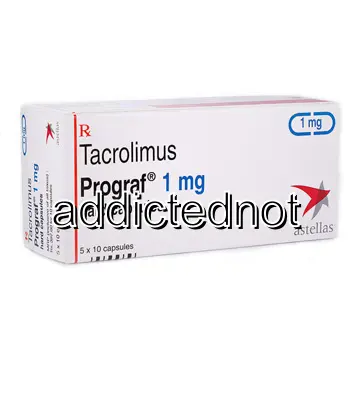| Package | Dosage | Price | Price per Dose | |
|---|---|---|---|---|
| Dosage: 0,5mg | ||||
| 90 pill | 0,5mg | €512.61 | €5.69 | |
| 60 pill | 0,5mg | €364.29 | €6.08 | |
| 30 pill | 0,5mg | €203.02 | €6.77 | |
| 20 pill | 0,5mg | €142.54 | €7.13 | |
| 10 pill | 0,5mg | €76.30 | €7.69 | |
| Dosage: 1mg | ||||
| 90 pill | 1mg | €719.96 | €8.01 | |
| 60 pill | 1mg | €515.49 | €8.60 | |
| 30 pill | 1mg | €303.81 | €10.11 | |
| 20 pill | 1mg | €226.06 | €11.29 | |
| 10 pill | 1mg | €126.70 | €12.73 | |
| Dosage: 5mg | ||||
| 20 pill | 5mg | €686.84 | €34.31 | |
| 10 pill | 5mg | €384.45 | €38.43 | |

Tacrolimus Description
Overview of Tacrolimus
Tacrolimus is a potent immunosuppressive medication primarily used to prevent organ rejection in transplant patients. It belongs to the class of calcineurin inhibitors, which work by suppressing the activity of the immune system, particularly T-lymphocytes. This helps to reduce the risk of the body's immune system attacking the transplanted organ, ensuring better graft survival and function.
How Tacrolimus Works
The medication operates by inhibiting the enzyme calcineurin, a critical component in the activation of T-cells. By blocking this enzyme, tacrolimus effectively diminishes the production of cytokines such as interleukin-2, which are essential for immune cell proliferation. This suppression prevents immune-mediated damage to the transplanted tissue and enhances the chances of a successful transplant outcome.
Uses and Application
Beyond transplantation, tacrolimus is also used topically to treat severe eczema, especially in cases where other medications have failed. When used as an oral medication in transplant recipients, dosage is carefully calibrated based on individual factors like weight, response, and kidney function. Close monitoring is essential to avoid potential side effects and ensure optimal effectiveness.
Potential Benefits
One of the notable advantages of tacrolimus is its high potency in preventing organ rejection. Patients often experience improved graft longevity when this drug is included as part of their immunosuppressive regimen. Additionally, compared to older drugs like cyclosporine, tacrolimus may offer a lower risk of certain side effects such as hypertension and cosmetic issues, though this varies per individual.
Side Effects and Precautions
Despite its benefits, tacrolimus can cause a range of side effects. Common issues include headaches, tremors, nausea, and elevated blood sugar levels. More serious risks involve kidney impairment, increased susceptibility to infections, and the potential development of malignancies over long-term use. Regular blood tests are essential to monitor drug levels, kidney function, and blood counts.
Safety and Interactions
Patients taking tacrolimus should be cautious about potential drug interactions. Medications such as certain antibiotics, antifungals, and other immunosuppressants can alter tacrolimus levels, increasing the risk of toxicity or reducing its efficacy. It is important to inform healthcare providers about all medications and supplements being used. Also, avoiding grapefruit and grapefruit juice is advised, as they can interfere with the metabolism of tacrolimus.
Conclusion
Tacrolimus remains a cornerstone in transplant medicine due to its powerful immunosuppressive properties. When used appropriately, with careful monitoring, it significantly improves the chances of transplant success. Patients should work closely with their healthcare team to manage dosages and watch for side effects, ensuring the best possible outcome from therapy with tacrolimus.
